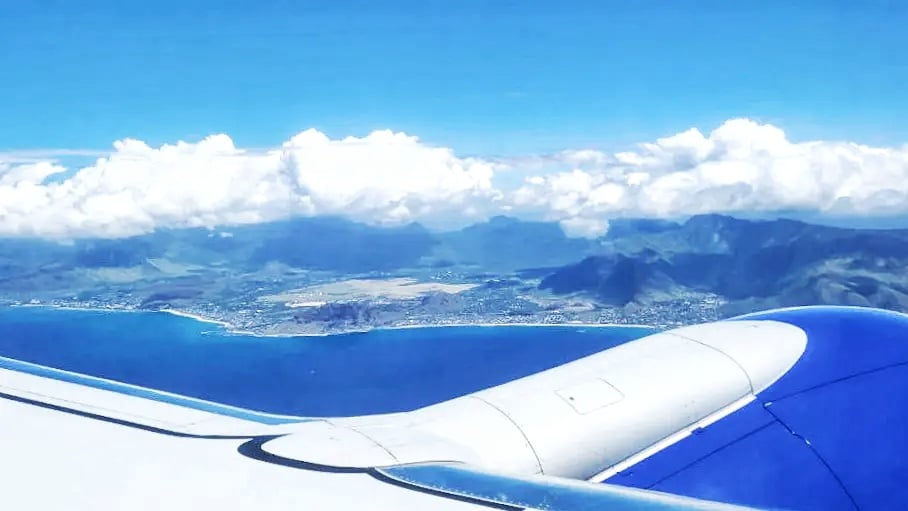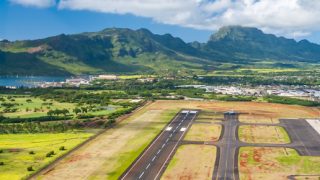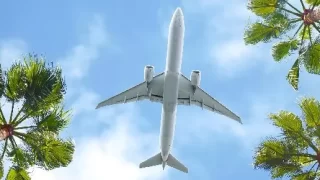For the first time since the Maui fires, Hawaii flight data shows Kauai and the Big Island surging ahead while Maui and Oahu hold steady. The new data reveals what many travelers have already sensed. Hawaii flights are quietly reshaping. While overall air capacity to the islands isn’t shrinking, the balance between islands is shifting faster than ever.
According to new state data from the Hawaii Tourism Authority and DBEDT, total nonstop airline seats to the islands for October through December 2025 will rise slightly by 1.9 percent compared to last year. That looks calm on the surface, yet beneath the surface the growth is anything but even.
Kauai surges ahead as Maui flight growth stalls.
Maui’s Kahului Airport, long seen as Hawaii’s second major air travel gateway, will see a modest 2.7% year-over-year increase in seats, lagging behind Kauai and the Big Island. Lihue Airport posts the strongest growth at nearly 6%, while Kona adds close to 3%, continuing its steady climb since 2019.
Those small relative moves translate into larger impacts. Airlines across the board are adding capacity where demand is steady and cutting back where recovery is less certain. For Maui, still navigating post-fire rebuilding, housing restrictions, and visitor confusion, the signal is clear: growth is cautious.
When compared with 2019, the changes become even clearer. Maui is down 15% from pre-pandemic capacity. Kona, at the other extreme, is up nearly 18%. Lihue is up about 6%, and even Honolulu reflects a modest gain.
That kind of reversal is unusual in Hawaii’s aviation history. It points to a more profound structural realignment in where travelers want to go and where airlines believe they are willing to spend money.
What’s behind the Hawaii flight shift.
There are both practical and emotional reasons. Maui has continued to send mixed messages for more than two years since the fires, asking visitors to return while also seeking to limit at least some short-term rentals while it tries to manage both a housing shortage and over-tourism. Visitors and airlines have taken note. BOH editors were on a flight last week and overheard a conversation between visitors who said, “They don’t want us there.”
By contrast, Kauai and the Big Island convey a steadier, more confident outlook. Resorts and vacation rentals there have largely recovered, and their visitor counts haven’t brought precisely the same political pressure. That makes them safer bets for airlines adjusting flight availability.
The data shows that the shift began even before the fires, but the last two years accelerated it. The state’s analysis confirms that Maui flights, reflected in air seat counts, haven’t recovered as well as those on the other islands.


Airline routes showing Hawaii’s biggest changes.
Hawaii’s air routes tell a revealing story. Las Vegas, up 179% in seats compared to 2019, has become one of Hawaii’s strongest mainland gateways, primarily fueled by Southwest’s growing hub and continued expansion there. Sacramento and Salt Lake City each show gains exceeding 40%. Seattle, long Alaska’s home base, has risen nearly 40% already, with more growth expected.
At the same time, Bay Area airports have lost capacity. Oakland is down 41% compared to 2019, San Jose is down 36%, and even San Francisco is down 18%. For Northern California travelers, access to Hawaii now means checking other routes or driving farther for better options.
International markets obviously remain most impacted. Seats from Japan are still down one-third from 2019. Canada is still below pre-pandemic strength, and Australia’s recovery has stumbled with both Sydney and Melbourne showing significant declines.
What Hawaii’s flight changes mean for travelers.
What makes this pattern remarkable is how it mirrors Hawaii’s broader tourism vibe. While the islands aren’t losing visitors, they are clearly seeing them redistributed. The same visitor who once defaulted to annual Maui vacations might now replace or augment that with a week on the Big Island or Kauai instead. Airlines are the first to respond to that behavior, far in advance when they schedule flights and aircraft types.
For both visitors and residents, these changes show up in traffic, prices, and the tone of local debate. More flights mean more jobs and tax revenue, but also renewed issues over where tourism is concentrating. The state’s goal remains to spread visitor demand more evenly, as is the situation in many similar places like French Polynesia. The airlines may be helping them do that.
What Hawaii visitors should expect next.
Flights to Kauai and the Big Island are most likely to remain competitively priced into 2026, particularly from west coast gateways. Maui fares could see more fluctuations as airlines adjust frequencies and test forward demand. Honolulu will remain Hawaii’s backbone hub with the most consistent schedules and connections across the Pacific.
For those planning Hawaii trips in 2026, this quiet shift may open some new opportunities and visitors may find better deals heading to Lihue and Kona.
The data, drawn from Cirium as of October 20, 2025, suggests the changes are both significant and long-lasting rather than a one-year anomaly. Maui’s flight capacity stagnation is ongoing, while the Big Island and Kauai are shaping into smaller neighbor island growth engines for Hawaii’s next tourism chapter.
Airlines will not say it this directly, but schedules indicate that Hawaii’s travel balance is shifting. How that plays out will depend on where you live and where you like to vacation.
Are you part of this shift, and have you noticed fewer Maui flight options or better deals to Kauai and the Big Island lately?
Get Breaking Hawaii Travel News







Kauai to hilo
Kauai to kona
Travel Safe less take off and landings/ More Safe
No wait honolulu/Way to dangerous whats going on,These planes can go
Way farther,Surfers Canoe paddlers Hula culture events/2 night stay in hilo or Kona
Package deal,big Money
Mahalo Air mokulele
Hawaiian Air,Flew better than today,Seriously!No cocktails,no Matai beer
This is Hawaii!Honolulu
Airport boring,15 a drink
The airline is blowing it.
These hotels are not full!
King Kam kona
Hilo double tree
Time for Change.
No mention of the fact that Alaska/Hawaiian supporting these routes is what’s driving growth and competition? I suppose that would risk acknowledging a benefit of the bailout to Hawai’i locals. United flies SFO-LIH/KOA/OGG, Southwest flies OAK-LIH/OGG, Hawaiian flies SFO/SJC-LIH, SFO/SJC-KOA, and SFO/OAK/SJC-OGG. (I probably missed some routes here.) Even as Alaska draws down its SFO/SJC operations, Hawaii service remains strong and competitive. Can’t imagine that would have been the case if Alaska hadn’t bailed Hawaiian out
Is this article talking about seat capacity or sold seats. Makes a big difference. The word from BOH and other sources is that tourism numbers are down. If this 6% increase in seats for Kauai stated in this article is for sold seats then it doesn’t jive with reports of tourist numbers down. Which is it?